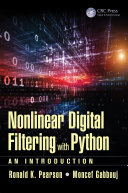

Most ebook files are in PDF format, so you can easily read them using various software such as Foxit Reader or directly on the Google Chrome browser.
Some ebook files are released by publishers in other formats such as .awz, .mobi, .epub, .fb2, etc. You may need to install specific software to read these formats on mobile/PC, such as Calibre.
Please read the tutorial at this link: https://ebookbell.com/faq
We offer FREE conversion to the popular formats you request; however, this may take some time. Therefore, right after payment, please email us, and we will try to provide the service as quickly as possible.
For some exceptional file formats or broken links (if any), please refrain from opening any disputes. Instead, email us first, and we will try to assist within a maximum of 6 hours.
EbookBell Team

4.1
10 reviewsNonlinear Digital Filtering with Python: An Introduction discusses important structural filter classes including the median filter and a number of its extensions (e.g., weighted and recursive median filters), and Volterra filters based on polynomial nonlinearities. Adopting both structural and behavioral approaches in characterizing and designing nonlinear digital filters, this book:
--Begins with an expedient introduction to programming in the free, open-source computing environment of Python
--Uses results from algebra and the theory of functional equations to construct and characterize behaviorally defined nonlinear filter classes
--Analyzes the impact of a range of useful interconnection strategies on filter behavior, providing Python implementations of the presented filters and interconnection strategies
Proposes practical, bottom-up strategies for designing more complex and capable filters from simpler components in a way that preserves the key properties of these components
--Illustrates the behavioral consequences of allowing recursive (i.e., feedback) interconnections in nonlinear digital filters while highlighting a challenging but promising research frontier
Nonlinear Digital Filtering with Python: An Introduction supplies essential knowledge useful for developing and implementing data cleaning filters for dynamic data analysis and time-series modeling.